Mechanics of Rainfall-Induced Landslides after a Prolonged Dry Period Based on Laboratory Tests and Numerical Models Incorporating Soil-Water Characteristic Curves
Abstract
1. Introduction
2. Material Properties
2.1. Index Properties of the Soil Sample
2.2. Soil Suction Measurement for SWCC Curves and Results
2.3. Preparation of a Saturated UCS Specimen for the Microwave Drying Process
3. Typical Slope Geometry Used for Explaining the Lunglei Slope Behavior
4. Rainfall Characteristics
5. Methodology
6. Results and Discussion
6.1. Soil Suction and the Properties of the Soil
6.2. Unconfined Compressive Strength Test Results
6.3. Reduction in Factor of Safety during Numerical Analysis
6.4. Variation in Pore Water Pressure and Matric Suction
7. Conclusions
- Microwave drying times vary based on soil density, with specimens of higher density taking longer to dry than those with lower density. Based on soil type and compaction levels, Figure 12 indicates that specimens used in this study with reduced saturation levels—80%, 60%, 40%, and 20% from an initial 100%—can be achieved through microwave drying for durations of 70, 110, 140, and 180 s, respectively.
- Matric suction in the soil is primarily determined by several soil properties, including water retention capacity, cohesion, mineral composition, temperature conditions and index properties of soil such as Atterberg’s limit, free swell index, and specific gravity.
- Soils with higher plasticity are observed to require more pressure for water extraction, leading to increased soil suction. This highlights the relationship between soil plasticity and the effort needed to reduce moisture content, directly impacting the soil’s suction capabilities.
- CI soil attains its highest Unconfined Compressive Strength (UCS) which is 564 kPa at a moisture saturation of 60% when compacted to its modified Proctor density. This moisture level is key to optimizing the soil structure and cohesion, enhancing its ability to support loads.
- A decline in moisture content to 20% leads to a notable drop in CI soil strength ranges between 103 kPa to 299 kPa for different compactions. This decrease is due to inadequate water for proper particle bonding, resulting in weaker cohesion and lower UCS values, showing how dry conditions undermine the soil’s integrity.
- Beyond the optimal saturation of 60%, at level 80% saturation, there is a progressive weakening of CI soil’s UCS up to 417 kPa. The additional moisture lubricates the soil particles, easing their movements under pressure and thus diminishing the soil strength and stability, especially as soil suction is reduced.
- The findings reveal that extreme moisture conditions—both overly saturated and significantly under-saturated—threaten slope stability. While saturated conditions decrease soil suction and shear strength, insufficient moisture undermines particle cohesion and overall soil strength, increasing the risk of slope failure.
- Maintaining CI soil around the 40% to 60% saturation level is crucial for maximizing its load-bearing properties and ensuring slope stability. This balance is vital for preventing slope failures, emphasizing the importance of monitoring and managing soil moisture levels in geotechnical engineering and construction projects.
- Apart from soil strength properties and slope geometry, the stability of slopes is significantly influenced by the duration and intensity of rainfall. The extent of infiltration is contingent upon the hydraulic characteristics of the soil. The fluctuation in simulated climate led to changes in the matric suction profile over different time periods. At the initial stage, the factor of safety was close to 2.0. During a 24 h period with rainfall intensity of 80 mm/day, the factor of safety decreased from 1.986 to 1.536, approaching a critical point. In a similar period with a higher rainfall intensity of 190 mm/day, the factor of safety further dropped to 0.879, creating a very critical condition.
- Rainfall characterized by low intensity and extended duration is more critical when compared to high intensity and short-duration rainfall.
- Slope failure originates from a decline in matric suction followed by an increase in pore water pressure. Matric suction becomes the crucial variable necessary for assessing the vulnerability of slope failures induced by rainfall.
- In regions such as Mizoram, a six-to-eight-month dry season induces substantial soil matric suction. Subsequently, heavy monsoonal activity reduces matric suction, and rainfall infiltration leads to an increase in pore water pressure. This increase in pore water pressure results in a notable mobilization of shear strength. Ultimately, the mobilized shear strength surpasses the resisting shear strength, particularly during the monsoon season, leading to the occurrence of shallow transitional landslides widely observed in the Lunglei district.
8. Future Scope
Author Contributions
Funding
Data Availability Statement
Conflicts of Interest
References
- Sorbino, G.; Nicotera, M. Unsaturated Soil Mechanics in Rainfall-Induced Flow Landslides. Eng. Geol. 2013, 165, 105–132. [Google Scholar] [CrossRef]
- Acharya, K.P.; Bhandary, N.P.; Dahal, R.K.; Yatabe, R. Seepage and Slope Stability Modelling of Rainfall-Induced Slope Failures in Topographic Hollows. Geomat. Nat. Hazards Risk 2014, 7, 721–746. [Google Scholar] [CrossRef]
- Sarkar, K.; Singh, A.K.; Niyogi, A.; Behera, P.K.; Verma, A.K.; Singh, T.N. The Assessment of Slope Stability along NH-22 in Rampur-Jhakri Area, Himachal Pradesh. J. Geol. Soc. India 2016, 88, 387–393. [Google Scholar] [CrossRef]
- Singh, A.K.; Kundu, J.; Sarkar, K. Stability Analysis of a Recurring Soil Slope Failure along NH-5, Himachal Himalaya, India. Nat. Hazards 2018, 90, 863–885. [Google Scholar] [CrossRef]
- Barman, J.; Biswas, B.; Das, J. Mizoram, the Capital of Landslide: A Review of Articles Published on Landslides in Mizoram, India; Springer: Cham, Switzerland, 2022; pp. 97–104. [Google Scholar] [CrossRef]
- Santhosh Kumar, V.; Sennimalai Chandrasekaran, S. Analysis of Failure of High Slope Subjected to Rainfall Infiltration at Peringavu in Kerala, India. Eng. Fail. Anal. 2022, 138, 106423. [Google Scholar] [CrossRef]
- Pachuau, L. Zonation of Landslide Susceptibility and Risk Assessment in Serchhip Town, Mizoram. J. Indian Soc. Remote Sens. 2019, 47, 1587–1597. [Google Scholar] [CrossRef]
- Lallianthanga, R.; Laltanpuia, Z. Landslide Hazard Zonation Mapping of Hnahthial Town, Mizoram, India Using Remote Sensing & GIS. Int. J. Eng. Tech. Res. 2014, 2, 56–63. [Google Scholar]
- Jain, N.; Martha, T.R.; Jalan, P.; Nanda, A. Landslide Atlas of India; National Remote Sensing Centre, ISRO, Department of Space, Government of India: Telangana, India, 2023.
- Talukdar, P.; Bora, R.; Dey, A. Numerical Investigation of Hill Slope Instability Due to Seepage and Anthropogenic Activities. Indian Geotech. J. 2018, 48, 585–594. [Google Scholar] [CrossRef]
- Government of Mizoram. Meteorological Data of Mizoram, 2021; Directorate of Economics & Statistics, Planning & Programme Implementation Department, Government of Mizoram: Guwahati, India, 2021.
- Rahardjo, H.; Kim, Y.; Satyanaga, A. Role of Unsaturated Soil Mechanics in Geotechnical Engineering. Int. J. Geo-Eng. 2019, 10, 8. [Google Scholar] [CrossRef]
- Fredlund, D.G.; Morgenstern, N.R.; Widger, R.A. The Shear Strength of Unsaturated Soils. Can. Geotech. J. 1978, 15, 313–321. [Google Scholar] [CrossRef]
- Lallianthanga, R.K.; Lalbiakmawia, F.; Lalramchuana, F. Landslide Hazard Zonation of Mamit Town, Mizoram, India Using Remote Sensing and GIS Techniques. Int. J. Geol. Earth Environ. Sci. 2013, 3, 184–194. [Google Scholar]
- Sanga, J.L.T. Mizoram State Disaster Management Plan 2021; Government of Mizoram: Aizwal, India, 2021; pp. 1–251.
- Lallianthanga, R.; Laltanpuia, Z.D. Landslide Hazard Zonation of Lunglei Town, Mizoram, India Using High Resolution Satellite Data. Int. J. Adv. Remote Sens. GIS 2013, 2, 148–159. [Google Scholar]
- Bhadiyadra, K.; Desai, N.; Sheth, K. Evaluation of SWCC Curves and Undrained Shear Parameters at Different Densities and Saturations of Unsaturated Clay; Springer: Singapore, 2021; pp. 533–542. [Google Scholar] [CrossRef]
- Zhang, L.L.; Fredlund, D.G.; Zhang, L.M.; Tang, W.H. Numerical Study of Soil Conditions under Which Matric Suction Can Be Maintained. Can. Geotech. J. 2004, 41, 569–582. [Google Scholar] [CrossRef]
- Merat, S.; Djerbal, L.; Bahar, R. Numerical Analysis of Climate Effect on Slope Stability. In PanAm Unsaturated Soils 2017; American Society of Civil Engineers: Dallas, TX, USA, 2018; pp. 308–318. [Google Scholar] [CrossRef]
- Omoregie, A.I.; Khoshdelnezamiha, G.; Senian, N.; Ong, D.E.L.; Nissom, P.M. Experimental Optimisation of Various Cultural Conditions on Urease Activity for Isolated Sporosarcina Pasteurii Strains and Evaluation of Their Biocement Potentials. Ecol. Eng. 2017, 109, 65–75. [Google Scholar] [CrossRef]
- Ng, L.T.; Ong, D.E.L.; Wong, W.S.H.; Gannilegedera, D.A.; Jong, B.F.; Chua, H.S. Real-time monitoring and assessment of groundwater responses due to dewatering of an abandoned 7m deep excavation pit in Kuching City. In Proceedings of the 14th International Conference of International Association for Computer Methods and Recent Advances in Geomechanics, 2014 (IACMAG 2014), Kyoto, Japan, 22–25 September 2014; pp. 1205–1211. [Google Scholar]
- Albanwan, H.; Qin, R.; Liu, J.-K. Remote Sensing-Based 3D Assessment of Landslides: A Review of the Data, Methods, and Applications. Remote Sens. 2024, 16, 455. [Google Scholar] [CrossRef]
- Kim, J.; Hwang, W.; Kim, Y. Effects of Hysteresis on Hydro-Mechanical Behavior of Unsaturated Soil. Eng. Geol. 2018, 245, 1–9. [Google Scholar] [CrossRef]
- Anderson, M.G.; Howes, S. Development and Application of a Combined Soil Water-Slope Stability Model. Q. J. Eng. Geol. 1985, 18, 225–236. [Google Scholar] [CrossRef]
- Zhao, F.; Miao, F.; Wu, Y.; Ke, C.; Gong, S.; Ding, Y. Refined Landslide Susceptibility Mapping in Township Area Using Ensemble Machine Learning Method under Dataset Replenishment Strategy. Gondwana Res. 2024, 131, 20–37. [Google Scholar] [CrossRef]
- Dutta, P.; Sarma, S. Landslide Susceptibility Zoning Of The Kalapahar Hill, Guwahati, Assam State, (India), Using A Gis-Based Heuristic Technique. Int. J. Remote Sens. Geosci. 2013, 2, 49–55. [Google Scholar]
- Leong, H.Y.; Ong, D.; Sanjayan, J.; Nazari, A. A Genetic Programming Predictive Model for Parametric Study on Factors Affecting Strength of Geopolymers. RSC Adv. 2015, 5, 85630–85639. [Google Scholar] [CrossRef]
- IS-2720-6; Methods of Test for Soils, Part VI: Determination of Shrinakge Factor. Bureau of Indian Standards: New Delhi, India, 1972.
- IS 2720-11; Methods of Test for Soils, Part 11: Determination of the Shear Strength Parameters of a Specimen Tested in Unconsolidated Undrained Triaxial Compression without the Measurement of Pore Water Pressure. Bureau of Indian Standards: New Delhi, India, 1993.
- IS 2720-10; Methods of Test for Soils, Part 10: Determination of Unconfined Compressive Strength. Bureau of Indian Standards: New Delhi, India, 1991. Available online: http://archive.org/details/gov.in.is.2720.10.1991 (accessed on 12 August 2023).
- IS 2720-7; Methods of Test for Soils, Part 7: Determination of Water Content-Dry Density Relation Using Light Compaction. Bureau of Indian Standards: New Delhi, India, 1980.
- IS 2720-8; Methods of Test for Soils, Part 8: Determination of Water Content-Dry Density Relation Using Heavy Compaction. Bureau of Indian Standards: New Delhi, India, 1983.
- IS 2720-5; Methods of Test for Soils, Part 5: Determination of Liquid and Plastic Limit. Bureau of Indian Standards: New Delhi, India, 1985.
- IS 2720-3-1; Methods of Test for Soils, Part 3: Determination of Specific Gravity, Section 1: Fine Grained Soils. Bureau of Indian Standards: New Delhi, India, 1980.
- IS 2720-2; Methods of Test for Soils, Part 2: Determination of Water Content. Bureau of Indian Standards: New Delhi, India, 1973.
- IS 2720-4; Methods of Test for Soils, Part 4: Grain Size Analysis. Bureau of Indian Standards: New Delhi, India, 1985.
- ASTM D5298-03; Test Method for Measurement of Soil Potential (Suction) Using Filter Paper. ASTM: West Conshohocken, PA, USA, 2003. [CrossRef]
- Van Genuchten, M.; Leij, F.; Yates, S.; Williams, J. The RETC Code for Quantifying Hydraulic Functions of Unsaturated Soils; U.S. Environmental Protection Agency: Washington, DC, USA, 1991; Volume 83, EPA/600/2-91/065 (NTIS 92-119668).
- Choudhury, C.; Tadikonda, B. Soil-Water Characteristic Curve Models For Clays. In Proceedings of the Indian Geotechnical Conference IGC-2014, Kakinada, India, 18–20 December 2014. [Google Scholar]
- ASTM D4643-08; Test Method for Determination of Water (Moisture) Content of Soil by Microwave Oven Heating. ASTM: West Conshohocken, PA, USA, 2017. [CrossRef]
- Brinkgreve, R.B.; Engin, J.E.; Swolfs, W.M. Plaxis 2D User Manual. Plaxis bv (2010). Bentaly Systems. Plaxis Groundwater Theory Manual, Note—PLAXIS LE Groundwater 1D/2D/3D Saturated/Unsaturated. Available online: https://communities.bentley.com/cfs-file/__key/communityserver-wikis-components-files/00-00-00-05-58/3113.PLAXIS2DCE_2D00_V20.02_2D00_2_2D00_Reference.pdf (accessed on 16 June 2024).
- Ong, D.; Yang, D.; Phang, S. Comparison of Finite Element Modelling of a Deep Excavation Using SAGE-CRISP and PLAXIS. In Proceedings of the International Conference on Deep Excavations, Singapore, 28–30 June 2006; pp. 28–30. [Google Scholar]
- Farthing, M.; Ogden, F. Numerical Solution of Richards’ Equation: A Review of Advances and Challenges. Soil. Sci. Soc. Am. J. 2017, 81, 1257–1269. [Google Scholar] [CrossRef]
- Cai, F.; Ugai, K. Numerical Analysis of Rainfall Effects on Slope Stability. Int. J. Geomech. 2004, 4, 69–78. [Google Scholar] [CrossRef]
- Chinkulkijniwat, A.; Horpibulsuk, S.; Semprich, S. Modeling of Coupled Mechanical-Hydrological Processes in Compressed-Air-Assisted Tunneling in Unconsolidated Sediments. Transp. Porous Media 2015, 108, 105–129. [Google Scholar] [CrossRef]
- Tinjum, J.M.; Benson, C.H.; Blotz, L.R. Soil-Water Characteristic Curves for Compacted Clays. J. Geotech. Geoenviron. Eng. 1997, 123, 1060–1069. [Google Scholar] [CrossRef]
- Zhou, J.-W.; Haibo, L.; Lu, G.; Zhou, Y.; Zhang, J.-Y.; Fan, G. Initiation Mechanism and Quantitative Mass Movement Analysis of the 2019 Shuicheng Catastrophic Landslide. Q. J. Eng. Geol. Hydrogeol. 2020, 54, qjegh2020-052. [Google Scholar] [CrossRef]
- Chong, E.E.-M.; Ong, D.E.-L. Data-Driven Field Observational Method of a Contiguous Bored Pile Wall System Affected by Accidental Groundwater Drawdown. Geosciences 2020, 10, 268. [Google Scholar] [CrossRef]
- Kramarenko, V.; Nikitenkov, A.; Matveenko, I.; Molokov, V.; Vasilenko, Y. Determination of Water Content in Clay and Organic Soil Using Microwave Oven. IOP Conf. Ser. Earth Environ. Sci. 2016, 43, 012029. [Google Scholar] [CrossRef]
- Naseer, S.; Evans, R. Effect of Rainfall Intensity and Duration on Stability of Natural Slopes of Unsaturated Fine Soils. In CSCE 31st August 2022: Proceedings Book; Shah, M., Ed.; Capital University of Science and Technology: Islamabad, Pakistan, 2022; pp. 405–411. [Google Scholar]
- Simeoni, L.; Tarantino, A.; Mongiovi, L. Effects of Unsaturation on the Stability of a Moraine Slope. In Unsaturated Soils: Experimental Studies; Schanz, T., Ed.; Springer: Berlin/Heidelberg, Germany, 2005; pp. 497–508. [Google Scholar] [CrossRef]
- Yubonchit, S.; Chinkulkijniwat, A.; Jothityangkoon, C.; Arulrajah, A.; Suddeepong, A. Influence Factors Involving Rainfall-Induced Shallow Slope Failure: Numerical Study. Int. J. Geomech. 2016, 17, 04016158. [Google Scholar] [CrossRef]
- Coates, D.R. Environmental Geology, 1st ed.; Wiley: Hoboken, NJ, USA, 1981. [Google Scholar]
- Ikeagwuani, C.C.; Nwonu, D.C. Emerging Trends in Expansive Soil Stabilisation: A Review. J. Rock. Mech. Geotech. Eng. 2019, 11, 423–440. [Google Scholar] [CrossRef]
- Azarafza, M.; Hajialilue Bonab, M.; Derakhshani, R. A Novel Empirical Classification Method for Weak Rock Slope Stability Analysis. Sci. Rep. 2022, 12, 14744. [Google Scholar] [CrossRef]
- Omoregie, A.I.; Palombo, E.A.; Ong, D.E.L.; Nissom, P.M. Biocementation of Sand by Sporosarcina Pasteurii Strain and Technical-Grade Cementation Reagents through Surface Percolation Treatment Method. Constr. Build. Mater. 2019, 228, 116828. [Google Scholar] [CrossRef]
- Travis, Q.; Houston, S.; Marinho, F.; Schmeeckle, M. Unsaturated Infinite Slope Stability Considering Surface Flux Conditions. Eng. J. Geotech. Geoenviron. Eng. 2009, 136, 963–974. [Google Scholar] [CrossRef]
- Omoregie, A.I.; Palombo, E.A.; Ong, D.E.L.; Nissom, P.M. A Feasible Scale-up Production of Sporosarcina Pasteurii Using Custom-Built Stirred Tank Reactor for in-Situ Soil Biocementation. Biocatal. Agric. Biotechnol. 2020, 24, 101544. [Google Scholar] [CrossRef]
- Hill, A. Microwave Ovens; ILSI Europe: Brussels, Belgium; ILSI Press: Washington, DC, USA, 1998. [Google Scholar]
- Leung, C.; Chow, K.; Shen, R. Behavior of Pile Subject to Excavation-Induced Soil Movement. J. Geotech. Geoenviron. Eng. J. Geotech. Geoenviron. Eng. 2000, 126, 947–954. [Google Scholar] [CrossRef]
- Pitchai, K.; Birla, S.L.; Subbiah, J.; Jones, D.; Thippareddi, H. Coupled Electromagnetic and Heat Transfer Model for Microwave Heating in Domestic Ovens. J. Food Eng. 2012, 112, 100–111. [Google Scholar] [CrossRef]

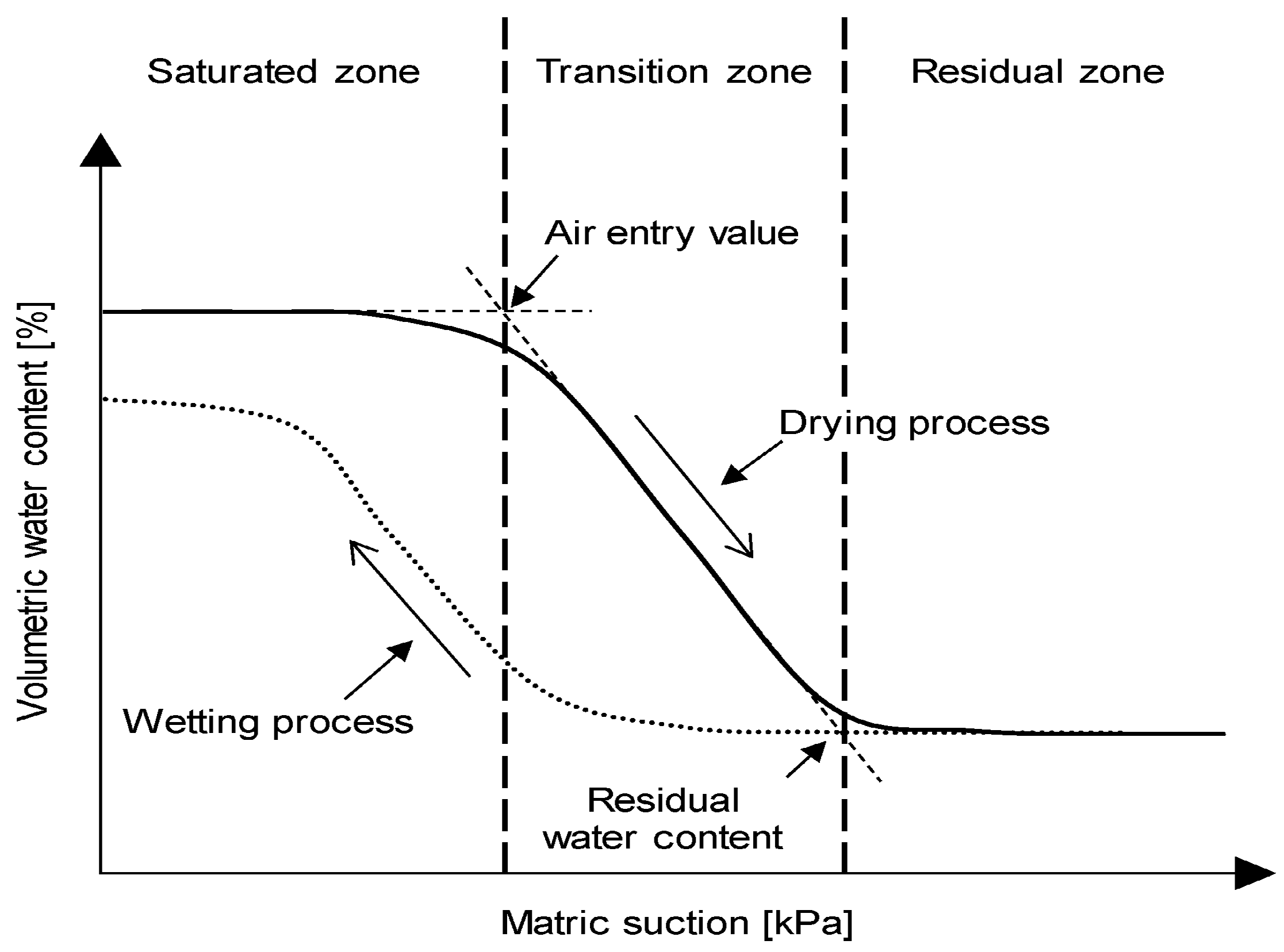
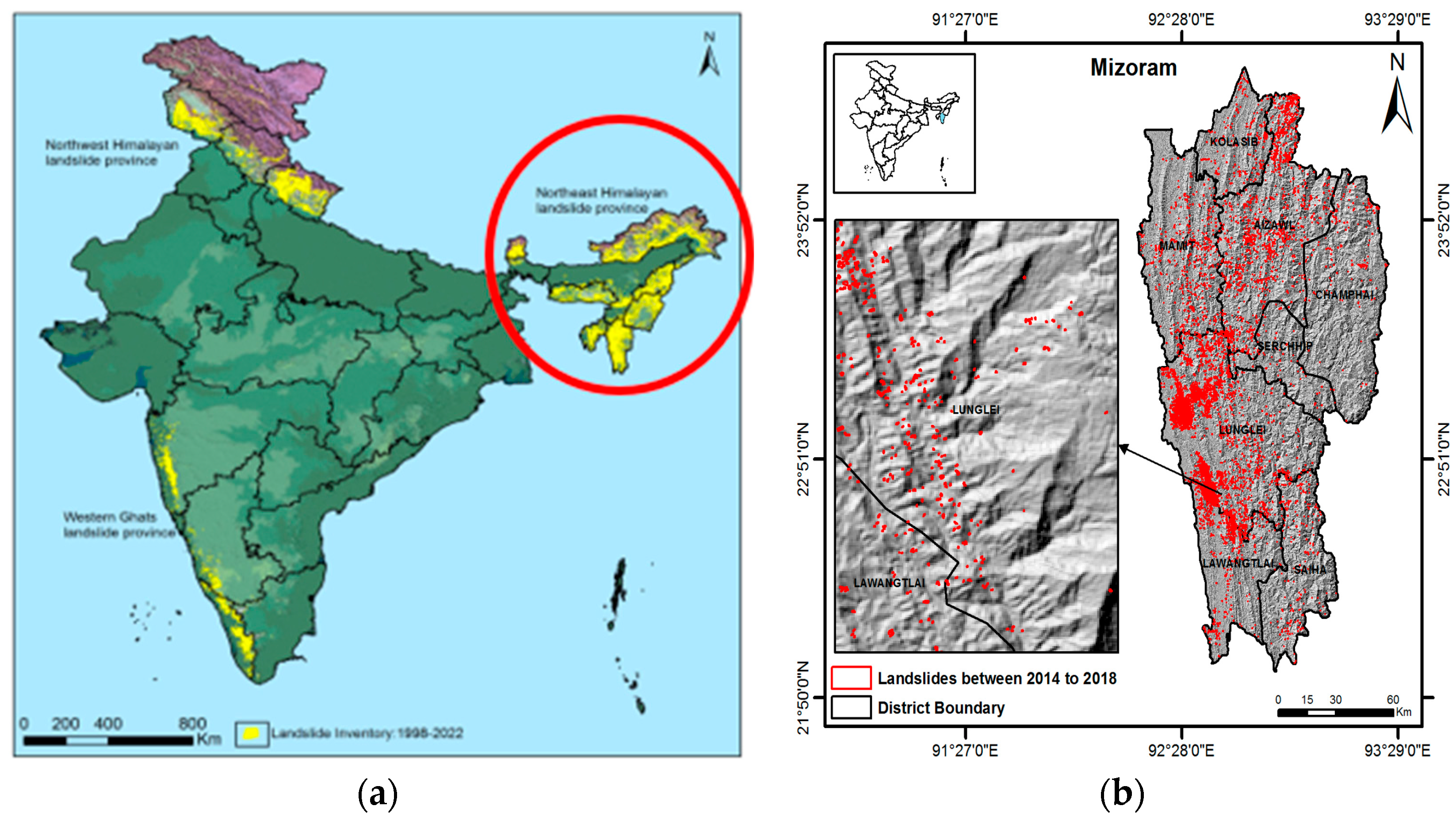
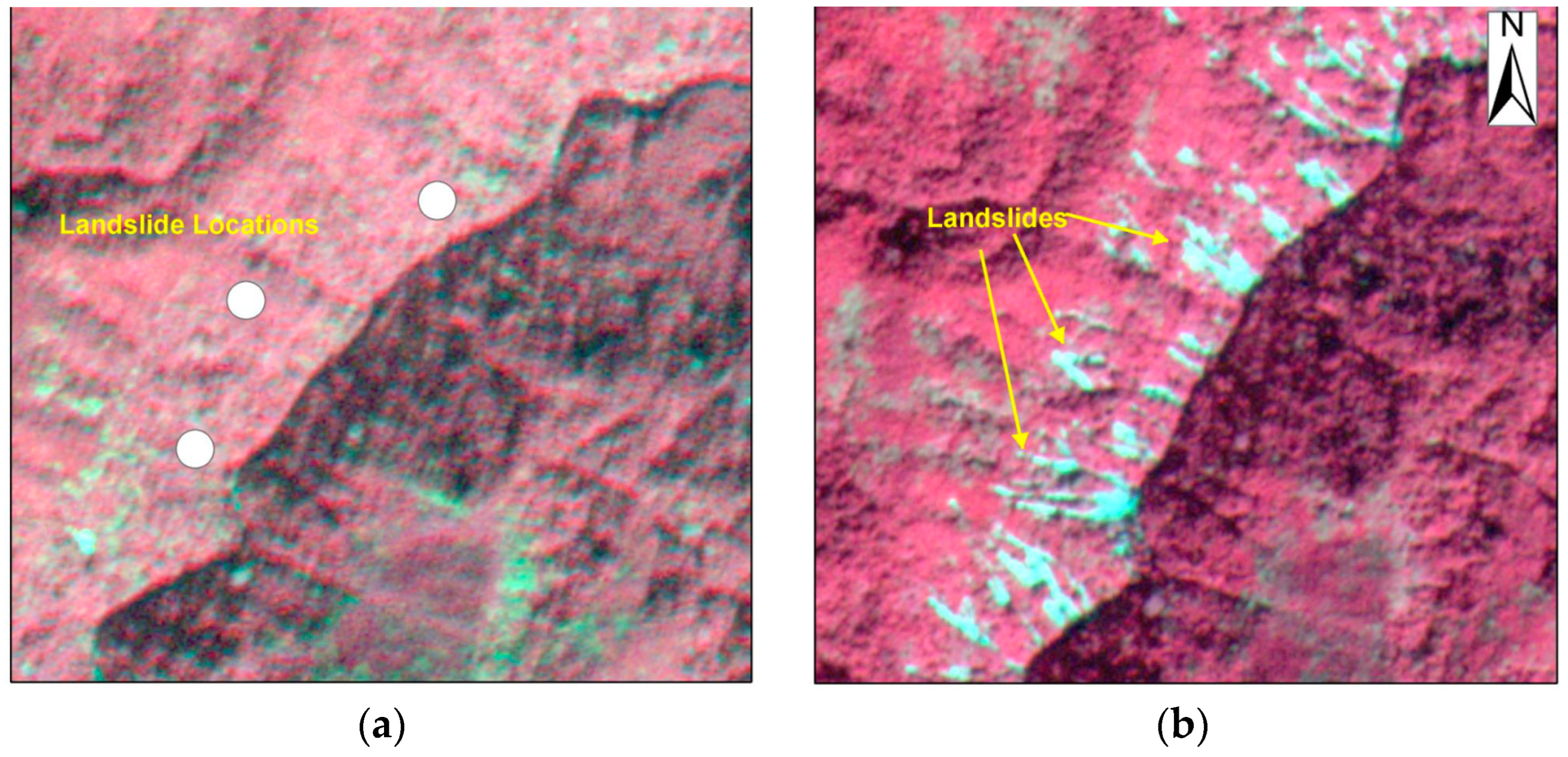
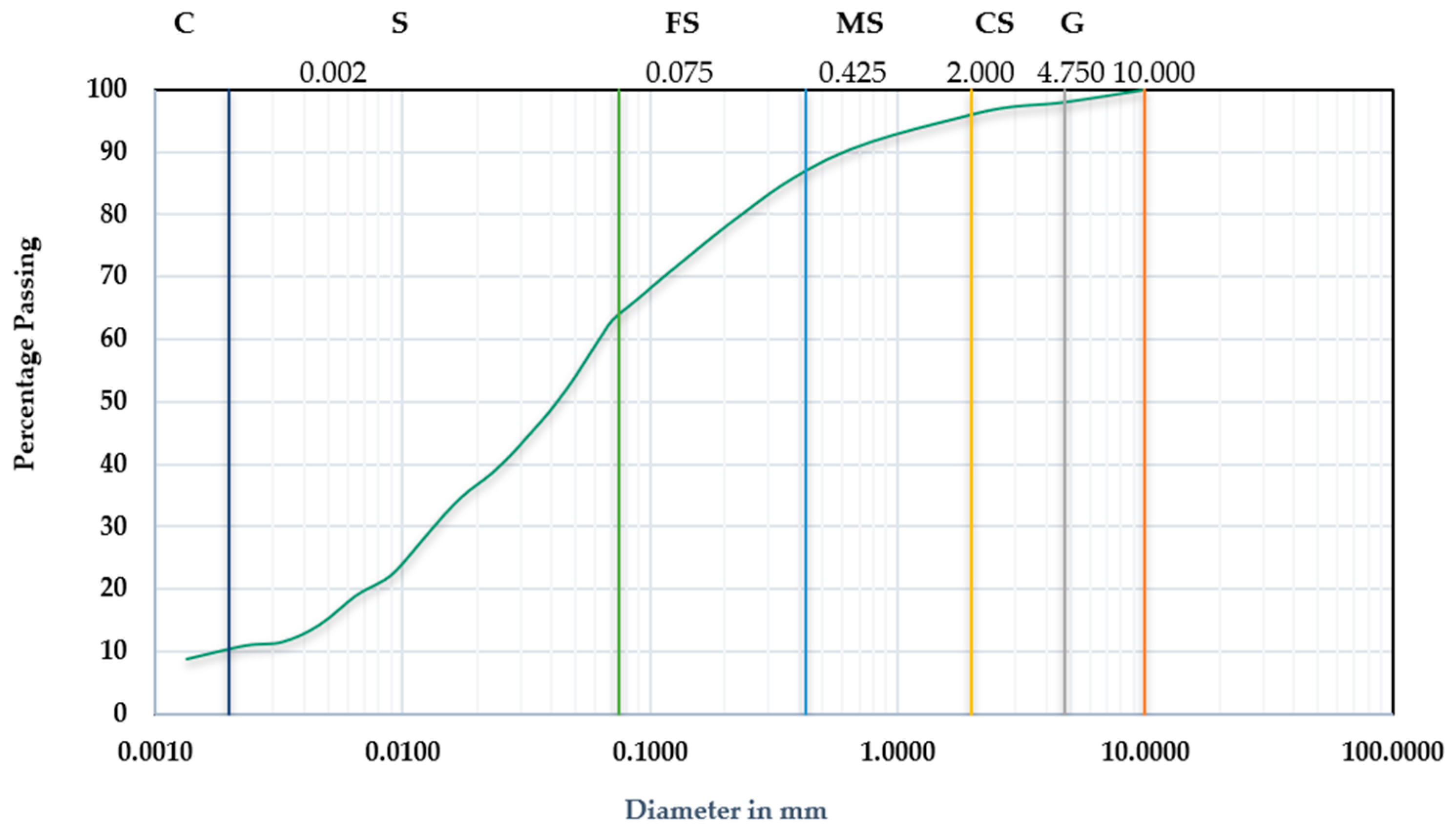
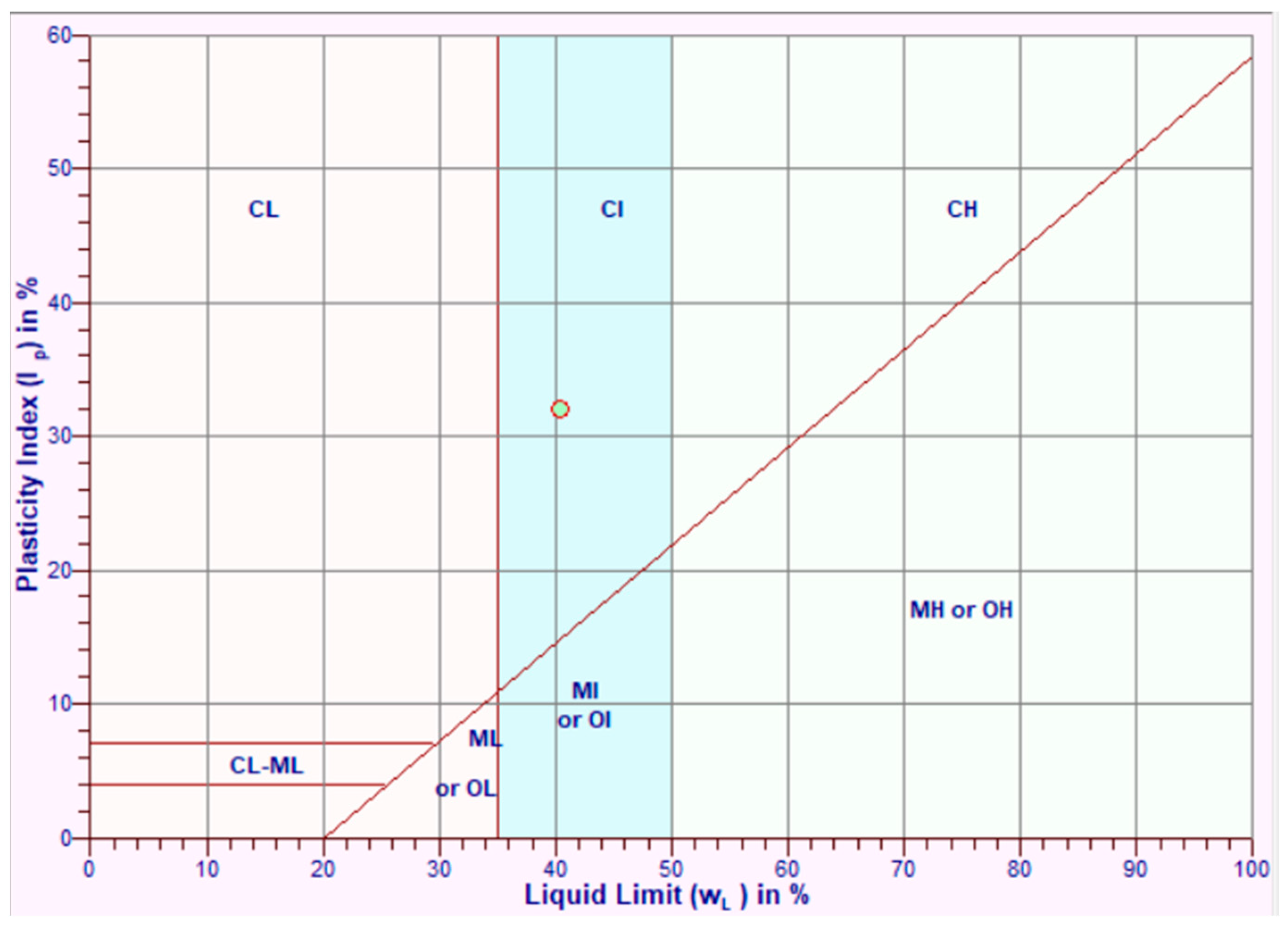
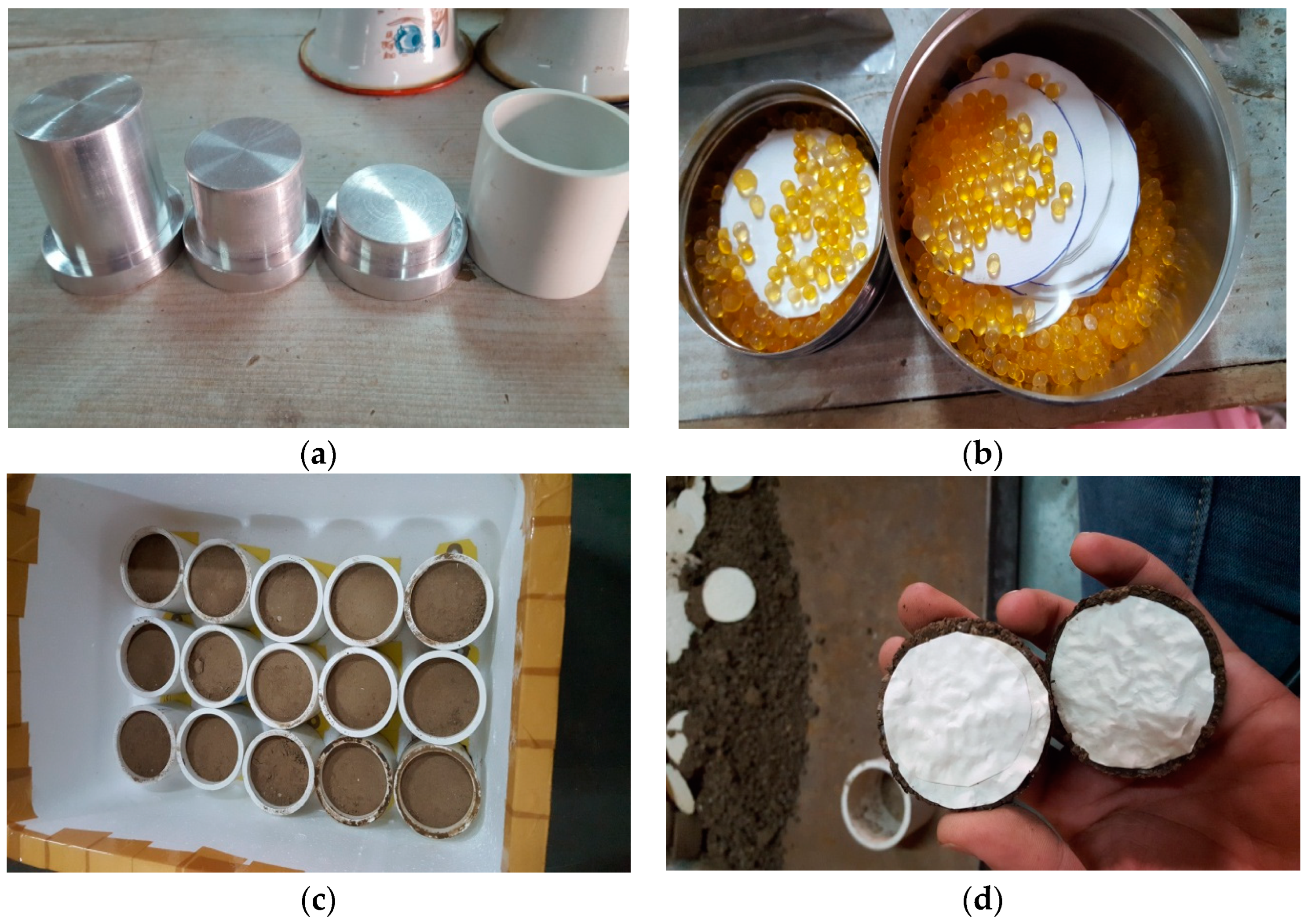

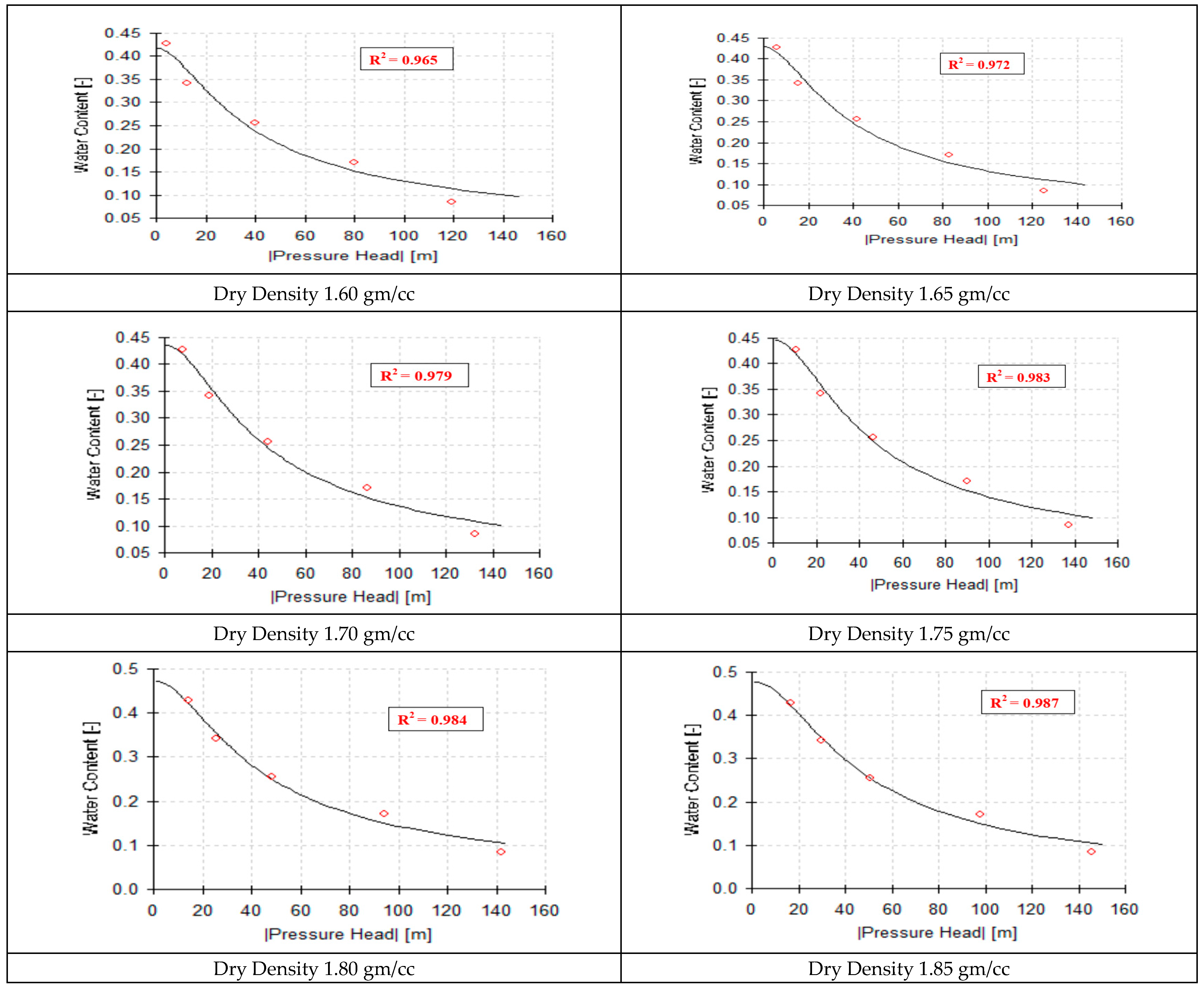
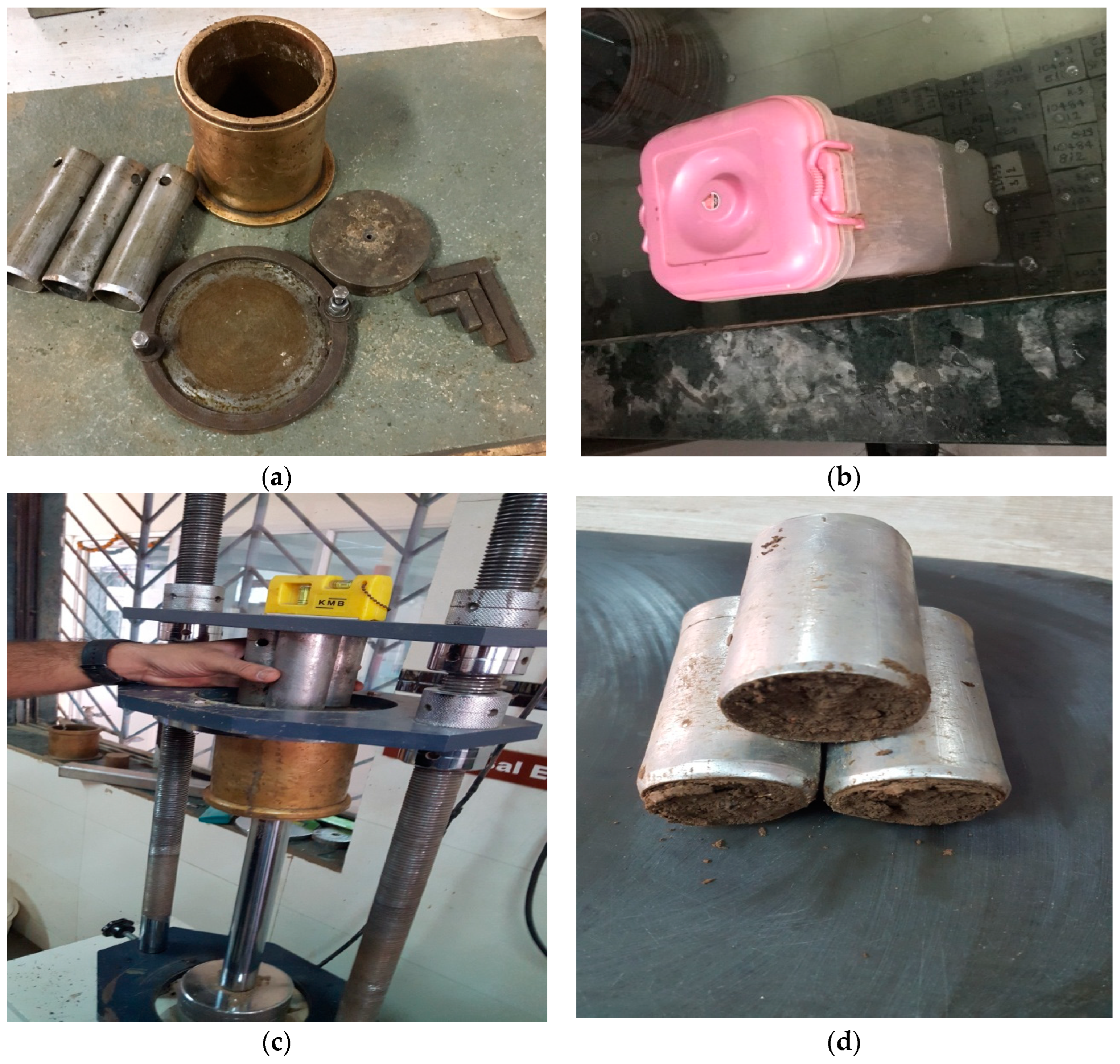



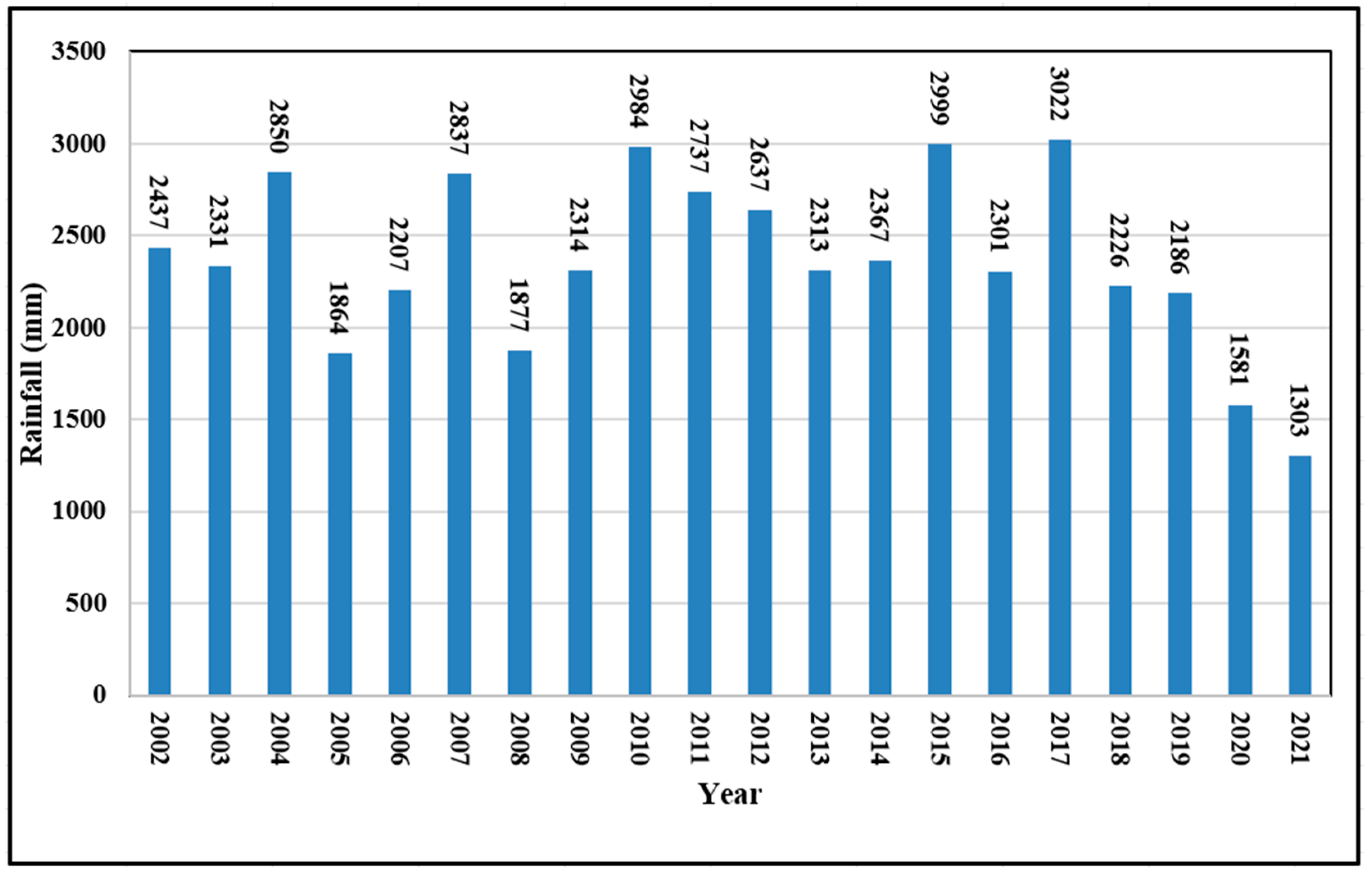

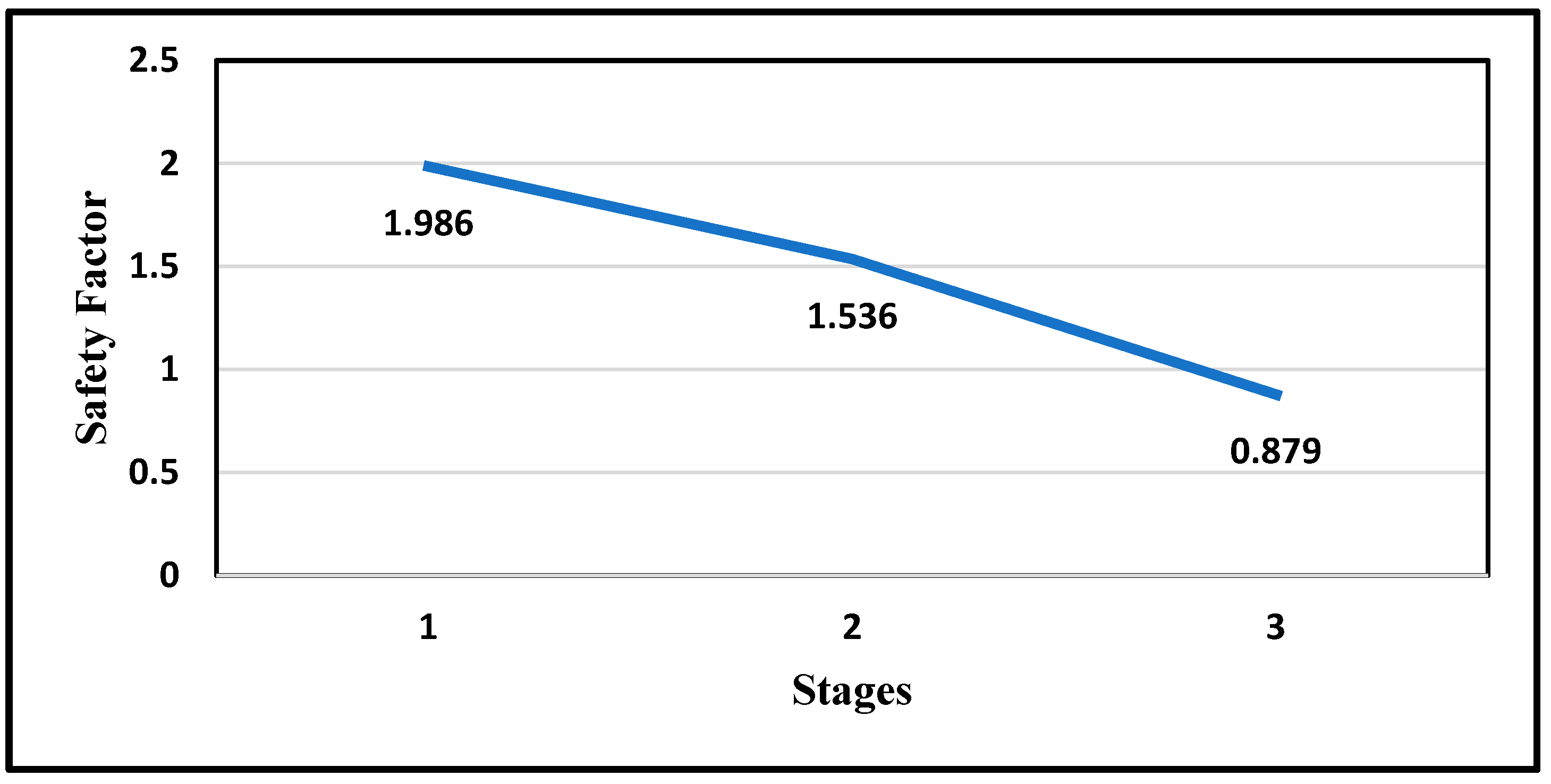
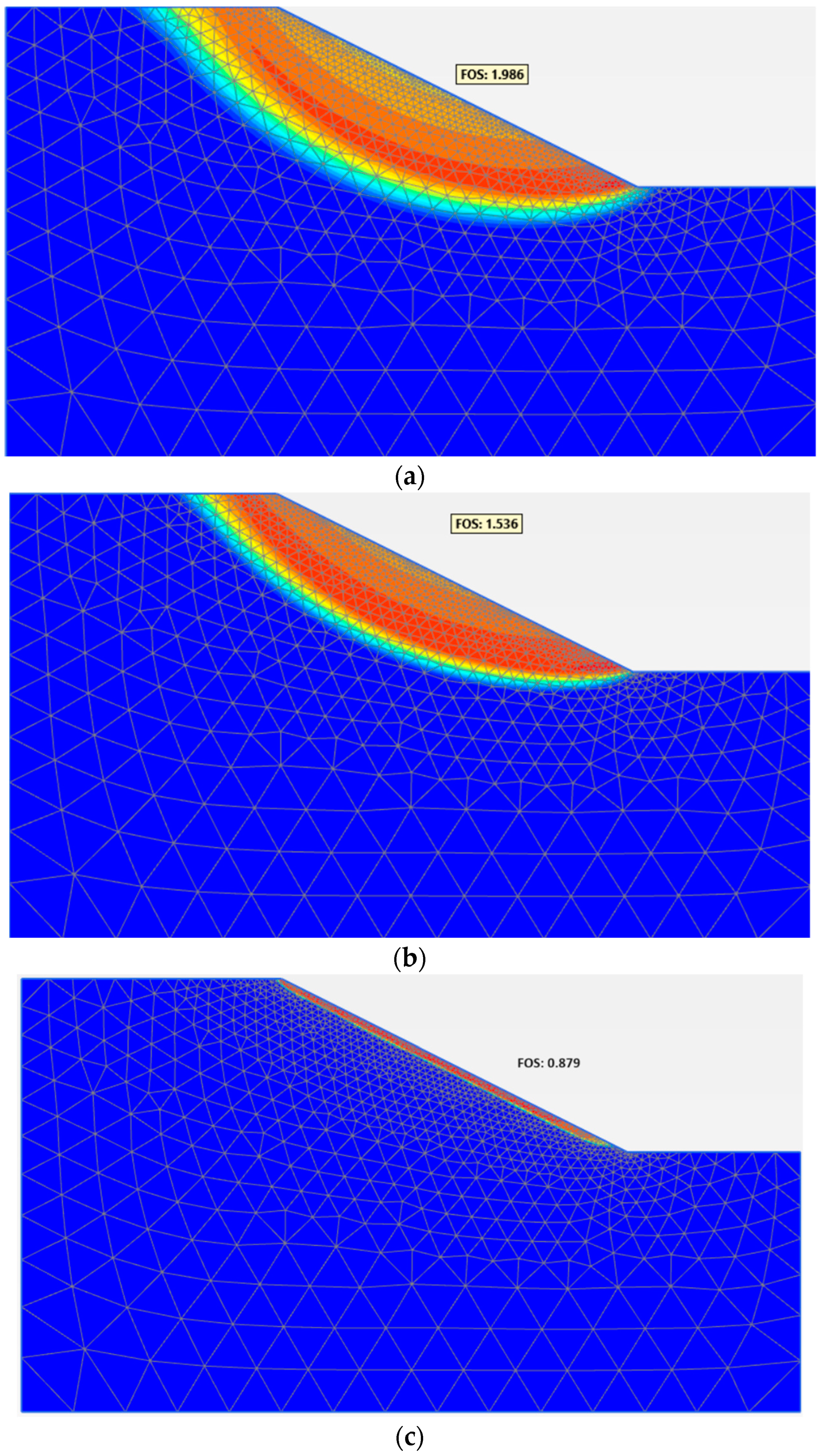
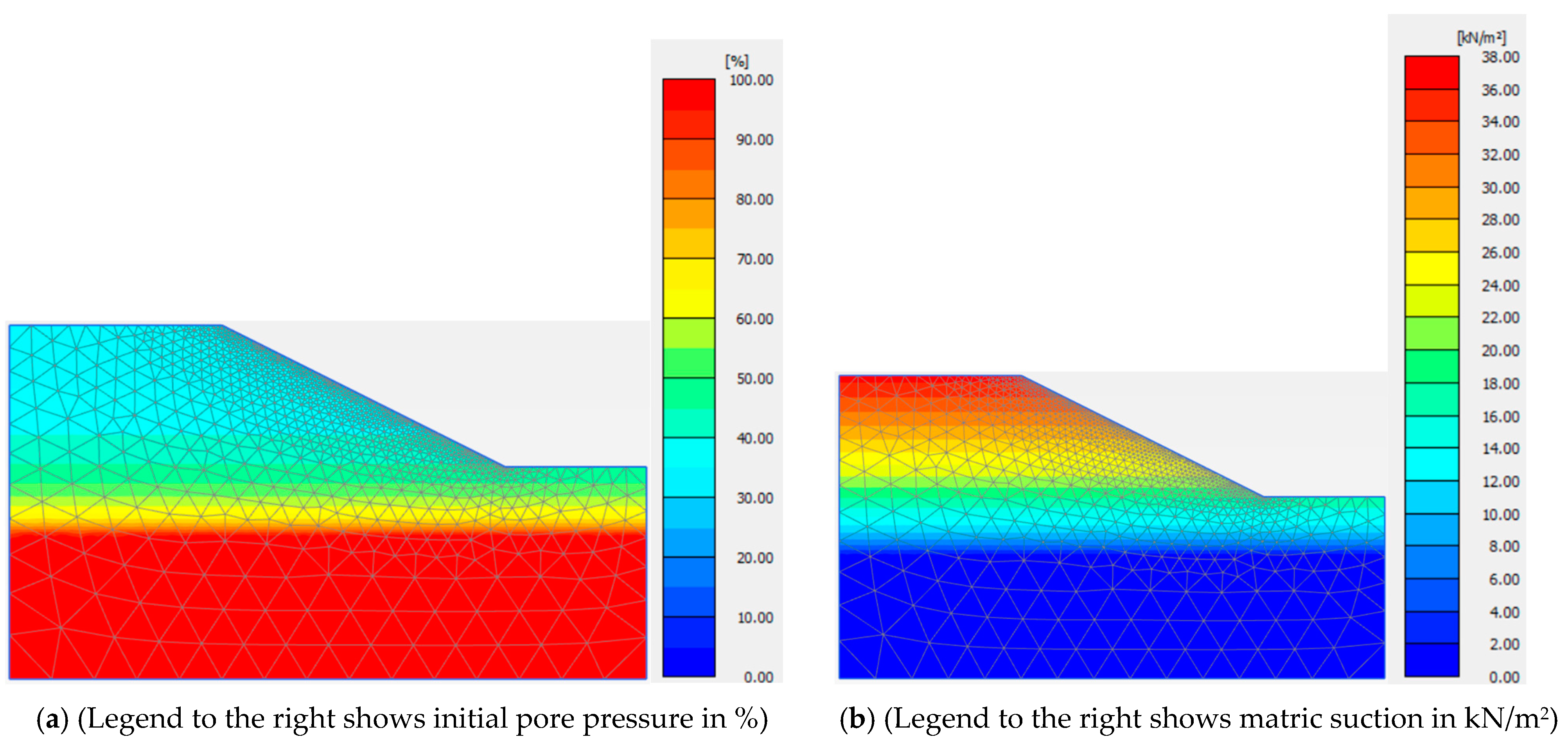

| Hazard Class | Area (Sq. km) | Percentage (%) |
|---|---|---|
| Very high | 1822.48 | 8.65 |
| High | 4263.79 | 20.22 |
| Moderate | 8903.47 | 42.24 |
| Low | 5011.57 | 23.77 |
| Very low | 968.72 | 4.60 |
| Water body | 111.97 | 0.53 |
| Index Properties of Soil | |
|---|---|
| Gravel % | 1.5 |
| Coarse Sand % | 1.5 |
| Medium Sand % | 5 |
| Fine Sand % | 22 |
| Silt + Clay % | 70 |
| Silt % | 59.72 |
| Clay % | 10.28 |
| Liquid Limit % | 40 |
| Plastic Limit % | 08 |
| Plasticity Index % | 32 |
| Specific Gravity | 2.794 |
| Free Swell Index | 15 |
| Standard Proctor Optimum Moisture Content (%) | 17.50 |
| Standard Proctor Maximum Dry Density (g/cm3) | 1.755 |
| Modified Proctor Optimum Moisture Content (%) | 16.82 |
| Modified Proctor Optimum Dry Density (g/cm3) | 1.853 |
| IS Classification | CI |
| Textural Classification | Silt Loam |
| Dry Density (g/cm3) | Saturation (%) | Water Content (%) | VWC | Matric Suction (kPa) |
|---|---|---|---|---|
| 1.6 | 20 | 5.342 | 0.085 | 1170 |
| 40 | 10.684 | 0.171 | 784 | |
| 60 | 16.025 | 0.256 | 389 | |
| 80 | 21.367 | 0.342 | 123 | |
| 100 | 26.709 | 0.427 | 37 | |
| 1.65 | 20 | 4.963 | 0.082 | 1227 |
| 40 | 9.926 | 0.164 | 812 | |
| 60 | 14.889 | 0.246 | 407 | |
| 80 | 19.852 | 0.328 | 152 | |
| 100 | 24.815 | 0.409 | 59 | |
| 1.7 | 20 | 4.607 | 0.078 | 1296 |
| 40 | 9.213 | 0.157 | 849 | |
| 60 | 13.820 | 0.235 | 432 | |
| 80 | 18.426 | 0.313 | 184 | |
| 100 | 23.033 | 0.392 | 76 | |
| 1.75 | 20 | 4.270 | 0.075 | 1342 |
| 40 | 8.541 | 0.149 | 881 | |
| 60 | 12.811 | 0.224 | 456 | |
| 80 | 17.082 | 0.299 | 217 | |
| 100 | 21.352 | 0.374 | 101 | |
| 1.8 | 20 | 3.953 | 0.071 | 1389 |
| 40 | 7.906 | 0.142 | 823 | |
| 60 | 11.859 | 0.213 | 471 | |
| 80 | 15.812 | 0.285 | 249 | |
| 100 | 19.765 | 0.356 | 139 | |
| 1.85 | 20 | 3.653 | 0.068 | 1427 |
| 40 | 7.305 | 0.135 | 959 | |
| 60 | 10.958 | 0.203 | 497 | |
| 80 | 14.610 | 0.270 | 289 | |
| 100 | 18.263 | 0.338 | 161 |
| Method Adopted | Cumulative Drying Using Single Specimen |
|---|---|
| Soil Type | CI Soil |
| Dry Density: | 1.60 g/cm3 to 1.85 g/cm3 |
| Initial Saturation (%) | 100% |
| Diameter of Specimens | 38 mm |
| Height of Specimens | 76 mm |
| Average Weight of Specimen | Ranges between 172 to 190 g |
| Microwave Condition | Microwaving without preheat and power saving mode (At 700 w) [6] |
| Dry Density (g/cm3) | 1.60 | 1.65 | 1.70 | 1.75 | 1.80 | 1.85 |
|---|---|---|---|---|---|---|
| Degree of Saturation (%) | Unconfined Compressive Strength (kPa) | |||||
| 20 | 103 | 134 | 299 | 254 | 232 | 195 |
| 40 | 132 | 352 | 384 | 229 | 413 | 554 |
| 60 | 197 | 335 | 474 | 411 | 550 | 564 |
| 80 | 179 | 208 | 232 | 434 | 530 | 417 |
| Parameters | Young’s Modulus (kN/m2) | Effective Cohesion (kN/m2) | Effective Friction Angle (°) | Poisson’s Ratio | Dilatancy Angle (°) | Eoedref (kN/m2) | Eurref (kN/m2) |
|---|---|---|---|---|---|---|---|
| Results | 20,000 | 0.5 | 30 | 0.20 | 0 | 60,000 | 20,000 |
Disclaimer/Publisher’s Note: The statements, opinions and data contained in all publications are solely those of the individual author(s) and contributor(s) and not of MDPI and/or the editor(s). MDPI and/or the editor(s) disclaim responsibility for any injury to people or property resulting from any ideas, methods, instructions or products referred to in the content. |
© 2024 by the authors. Licensee MDPI, Basel, Switzerland. This article is an open access article distributed under the terms and conditions of the Creative Commons Attribution (CC BY) license (https://creativecommons.org/licenses/by/4.0/).
Share and Cite
Bhadiyadra, K.; Ong, D.E.L. Mechanics of Rainfall-Induced Landslides after a Prolonged Dry Period Based on Laboratory Tests and Numerical Models Incorporating Soil-Water Characteristic Curves. Geosciences 2024, 14, 174. https://doi.org/10.3390/geosciences14070174
Bhadiyadra K, Ong DEL. Mechanics of Rainfall-Induced Landslides after a Prolonged Dry Period Based on Laboratory Tests and Numerical Models Incorporating Soil-Water Characteristic Curves. Geosciences. 2024; 14(7):174. https://doi.org/10.3390/geosciences14070174
Chicago/Turabian StyleBhadiyadra, Kishan, and Dominic E. L. Ong. 2024. "Mechanics of Rainfall-Induced Landslides after a Prolonged Dry Period Based on Laboratory Tests and Numerical Models Incorporating Soil-Water Characteristic Curves" Geosciences 14, no. 7: 174. https://doi.org/10.3390/geosciences14070174
APA StyleBhadiyadra, K., & Ong, D. E. L. (2024). Mechanics of Rainfall-Induced Landslides after a Prolonged Dry Period Based on Laboratory Tests and Numerical Models Incorporating Soil-Water Characteristic Curves. Geosciences, 14(7), 174. https://doi.org/10.3390/geosciences14070174








